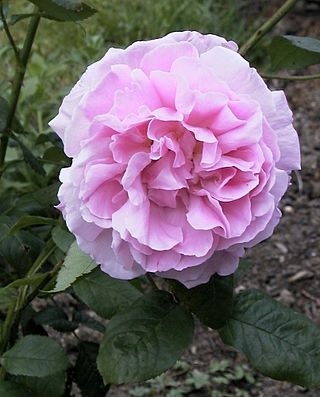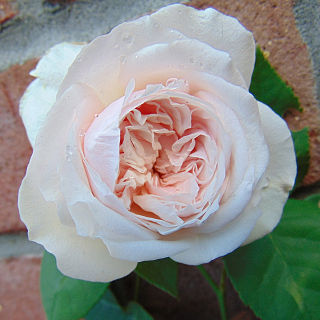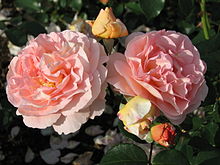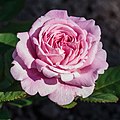
Rosa 'Ispahan', also known as 'Rose d'Ispahan' and 'Pompon des Princes', is a clear pink, half-open kind of Damask rose, a type of garden rose introduced from the Middle East to Europe during the crusading 13th century.

The Royal William rose, registered under the cultivar name "KORzaun", is a red hybrid tea rose. It was developed by Reimer Kordes from the cultivar 'Feuerzauber' and is available under several other marketing names, such as Fragrant Charm, Duftzauber, La Magie du Parfum and Leonora Christine.

Rosa 'Harison's Yellow', also known as R. × harisonii, the Oregon Trail Rose or the Yellow Rose of Texas, is a rose cultivar which originated as a chance hybrid in the early 19th century. It probably is a seedling of Rosa foetida and Rosa pimpinellifolia. The cultivar first bloomed at the suburban villa of George Folliott Harison, attorney, between 8th and 9th Avenues on 32nd Street, north of New York City. The site of Harison's villa is now just south of the present General Post Office. The nurseryman William Prince of Flushing, Long Island took cuttings and marketed the rose in 1830. 'Harison's Yellow' is naturalized at abandoned house sites through the west and is found as a feral rose along the Oregon Trail.

Rosa 'La France' is a pink rose cultivar found in France in 1867 by the rosarian Jean-Baptiste André Guillot (1827–1893). It is generally accepted to be the first hybrid tea rose. Its introduction is therefore also considered the birth of the modern rose. As the cultivar was not systematically bred, its hybrid parentage can only be speculated, but 'Madame Falcot' is considered as a possible parent.

Rosa'KORbin' is a white floribunda rose cultivar bred by Kordes in Germany in 1958. It is also known as Iceberg, Fée des Neiges and Schneewittchen. 'KORbin' is among the world's best known roses.

Rosa'Veilchenblau' is a mauve hybrid multiflora rose cultivar and the best known violet rambler. Other names are 'Bleu-Violet', 'Blue Rambler', 'Blue Rosalie' and 'Violet Blue'.

Rosa 'Mrs. Harkness' is a rare light pink rose cultivar discovered by George Paul in Great Britain in 1893. It is a sport of the deep pink hybrid perpetual 'Heinrich Schultheis', introduced by Henry Bennet in 1882. The RHS Encyclopedia of Roses lists 'Paul's Early Blush' and 'Mrs Harkness' as two separate sports of 'Heinrich Schultheis', while Peter Beales uses the names synonymously.

A rose garden or rosarium is a garden or park, often open to the public, used to present and grow various types of garden roses, and sometimes rose species. Designs vary tremendously and roses may be displayed alongside other plants or grouped by individual variety, colour or class in rose beds. Technically it is a specialized type of shrub garden, but normally treated as a type of flower garden, if only because its origins in Europe go back to at least the Middle Ages in Europe, when roses were effectively the largest and most popular flowers, already existing in numerous garden cultivars.

Peter Lambert was a German rose breeder from Trier.

The Rosarium Uetersen is a rose garden located in the Rosenstadt Uetersen, Schleswig-Holstein, Germany, and is the oldest and largest rose garden in Northern Germany.

Rosa 'Eden' is a light pink and white climbing rose. The cultivar was created by Marie-Louise Meilland and introduced in France by Meilland International in 1985 as part of the Renaissance® Collection. It was named 'Pierre de Ronsard', after the French Renaissance poet Pierre de Ronsard in reference to his famous ode that begins: Mignonne, allons voir si la rose for the 400th death anniversary celebrations of the poet. The cultivar is also called 'Eden Rose 85' as Meilland had already introduced a rose cultivar called 'Eden' in the 1950s.

Rosa 'Pink Wonder' is a light pink floribunda rose cultivar. It was bred in 1970 by Meilland International in France.

Rosa 'Garden Party' is an ivory hybrid tea rose cultivar created by Herbert C. Swim in 1959. Its parents are the hybrid teas 'Charlotte Armstrong' and 'Peace'.

Rosa 'Old Blush', also known as 'Parsons' Pink China', 'Old Blush China', 'Old China Monthly', is a China rose and has been cultivated in China for about a thousand years. It derives from Rosa chinensis, and is generally accepted as the first East Asian rose cultivar to reach Europe. It is recorded in Sweden in 1752 and in England before 1759, but was probably cultivated in China for several centuries. It is believed to be the rose which inspired the song The Last Rose of Summer by the Irish composer and poet Thomas Moore. It is also known as Parsons' Pink China, named after Mr Parson who introduced it commercially to the UK in 1793.

Rosa 'Nevada' is a white climbing rose cultivar developed by Pedro Dot in Spain in 1927. It is one of his most successful creations and is named for its colour, as nevada is the Spanish word for "snowy". Its parentage was long under discussion, as Dot introduced the cultivar as a hybrid moyesii, but the cultivar's round, black hips point to its R. pimpinellifolia-parentage. It is probably a cross between Dot's pink hybrid tea 'La Giralda' and the wild rose species Rosa pimpinellifolia var. altaica, but is sometimes still described as a hybrid moyesii.

Rosa 'Wife of Bath', is a pink shrub rose cultivar developed by David C.H. Austin in England in 1969. It was one of his early cultivars and is named after a character from Geoffrey Chaucer's The Canterbury Tales. 'Rosarium Glücksburg' is a rose garden in the park of Schloss Glücksburg in Glücksburg, Germany.

Rosa 'Albéric Barbier' is a popular Hybrid wichurana rose cultivar that was bred in 1900 by Barbier Frères & Compagnie. Its parents were R. wichurana and the yellow hybrid tea 'Shirley Hibberd', named after the Victorian gardening writer (1825–1890).

Rosa'Elina' is a light yellow hybrid tea rose bred by Patrick Dickson of Northern Ireland in 1983. The variety was developed from the white floribunda 'Nana Mouskouri' and the apricot hybrid tea 'Lolita'.

Rosa'Souvenir de la Malmaison' is a rose cultivar with large, very pale pink flowers that open flat. The Bourbon rose was created in 1843 by Lyon rose breeder Jean Béluze, who named it after the Château de Malmaison, where Joséphine de Beauharnais (1763–1814) had created a magnificent rose garden. It is probably a cross between 'Mme Desprez' and 'Devoniensis'.
























